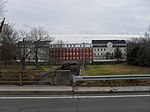Samuel Taft House
Houses completed in 1774Houses in Uxbridge, MassachusettsHouses on the National Register of Historic Places in Worcester County, MassachusettsNational Register of Historic Places in Uxbridge, MassachusettsWorcester County, Massachusetts Registered Historic Place stubs

The Samuel Taft House is a historic house at 87 Sutton Street in Uxbridge, Massachusetts. The main block of the 1+1⁄2 story timber-frame house was built in 1774, and is a typical local variant of Georgian styling, with a gambrel roof, central chimney, clapboard siding, and granite foundation. The house is notable for its association with Samuel Taft, who served in the American Revolutionary War, and hosted George Washington at this house in 1789.The house was listed on the National Register of Historic Places in 1983.
Excerpt from the Wikipedia article Samuel Taft House (License: CC BY-SA 3.0, Authors, Images).Samuel Taft House
Sutton Street,
Geographical coordinates (GPS) Address Nearby Places Show on map
Geographical coordinates (GPS)
| Latitude | Longitude |
|---|---|
| N 42.091111111111 ° | E -71.655833333333 ° |
Address
Sutton Street 92
01538
Massachusetts, United States
Open on Google Maps










